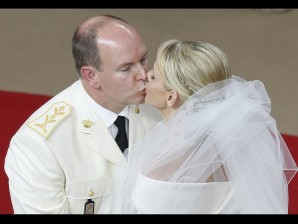
Prince Albert II of Monaco kisses his bride Charlene Princess of Monaco during their religious wedding ceremony at the Monaco palace Saturday. AP
MONACO—Prince Albert II of Monaco and his South African bride Princess Charlene married in a religious ceremony on Saturday, solemnizing their union in front of 800 royal and celebrity guests.
Arrayed in a stunning Armani gown cut from 130 meters of silk and studded with 40,000 crystals, the world’s newest royal stole occasional smiling glances at her husband and after the vows, which followed Friday’s civil wedding.
Archbishop Bernard Barsi of Monaco asked each whether they accepted each other “for better, for worse, for richer, for poorer, in sickness and in health, until death do you part.” Both replied with a firm: “Yes.”
Then, in front of witnesses, the couple — Charlene, noticeably less tense than she had been at the first ceremony, and occasionally smiling — exchanged 18-carat rings in white gold and platinum by the House of Cartier.
South African singer Pumela Matshikiza celebrated with a popular, upbeat wedding song from Charlene’s homeland: “Diviner of the roadways, the knock knock beetle / It just passed by here, the knock knock beetle.”
Some 800 guests attended the service in the palace, and another 3,800 were outside watching on a large screen, cheering as popular guests like James Bond actor Roger Moore and former French first lady Bernadette Chirac arrived.
Aside from France’s President Nicolas Sarkozy and the kings and queens of Sweden and Belgium, the crowd included fashion designers, models, sportsmen, more minor royals and senior officials from the tiny principality.
Organizers hoped the glamour of the spectacle would distract from gossip after Monaco officials privately admitted there is “truth” in a rumour that Albert faces a paternity test following a claim by a pregnant former lover.
Reports the princess was furious and threatened to leave when she learned her prince’s latest secret had overshadowed the build-up to the wedding, but the event itself has gone smoothly and the Monegasques are philosophical.
Organizers admitted, however, that there had been a “hiccup” in preparations following an incident at Monaco’s heliport, but did not confirm reports that Charlene had contemplated fleeing home to South Africa.
“We can’t remake the prince. It’s a modern marriage. Charlene has known him for a long time and accepts it,” shrugged a 30-something wellwisher, insisting on remaining anonymous like many of Monaco’s 7,810-strong native population.
Albert, at 53, is two decades older than his blonde bride and has two children from previous relationships.
But even if a third or a fourth is confirmed he will still not have an official heir until his lawful wife bears him one.
“We just want the Grimaldi dynasty to continue,” said a 72-year-old Monegasque, a direct descendant of a group of Genoan migrants who settled the rocky Riviera outcrop and future tax haven in 1775.
Guests arrived in a cavalcade of 200 BMW 7 Series limousines and striding across the red carpet towards the palace, with early arrivals including Czech supermodel Karolina Kurkova and retired tennis ace Henri Leconte.
Pop star Jean-Michel Jarre received warm applause from locals still grateful for the previous night’s spectacular concert. Heels were high, hats were broad and many guests seemed to have ignored a request for covered shoulders.
Charlene had appeared tense but poised at her civil marriage ceremony on Friday in the throne room of her palace, but relaxed slightly at a buffet for Monaco’s people, where she posed for pictures and hugged babies.
Later, she and the prince joined an estimated 80,000 people, double the normal population of the state, at the waterfront for Jarre’s show.
The bride and her beau were to cross the city state in an open-topped Lexus hybrid, a gesture to the prince’s green credentials amid otherwise extravagant scenes of champagne quaffing and fireworks.
The wedding feast will be held at the opera house opposite the casino, a site of glamor in an otherwise grim jungle of concrete 1970s blocks, and — with private banking — the source of much of the city-state’s wealth.